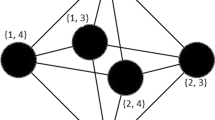Abstract
A t-\((v,k,\lambda )\) design is a pair \((X,\mathcal{B})\), where X is a v-element set and \(\mathcal{B}\) is a set of k-subsets of X, called blocks, with the property that every t-subset of X is contained in exactly \(\lambda \) blocks. A t-\((v,k,\lambda )\) design \((X,\mathcal{B})\) is said to be \((s,\mu )\)-resolvable if \(\mathcal{B}\) can be partitioned into \(\mathcal{B}_1|\cdots |\mathcal{B}_c\) such that each \((X,\mathcal{B}_i)\) is an s-\((v,k,\mu )\) design, further, if each \((X,\mathcal{B}_i)\) is also \((r,\nu )\)-resolvable, then such an \((s,\mu )\)-resolvable t-design is called \((s,\mu )(r,\nu )\)-doubly resolvable. In 1980, Hartman constructed a (2, 3)(1, 1)-doubly resolvable 3-(v, 4, 1) design for \(v\in \{20,32,44,68,80,104\}\) and a (2, 3)-resolvable 3-\((2^7,4,1)\) design. In this paper, we construct (2, 3)(1, 1)-doubly resolvable 3-\((2^{2n+1},4,1)\) designs for all positive integers n.
Similar content being viewed by others
References
Abel R.J.R., Ge G., Yin J.: Resolvable and near-resolvable designs. In: Colbourn C.J., Dinitz J.H. (eds.) CRC Handbokk of Combinatorial Designs, pp. 124–132. CRC Press, Boca Raton (2007).
Baker R.D.: Partitioning the planes of \(AG_{2m}(2)\) into 2-designs. Discret. Math. 15, 205–211 (1976).
Bush K.A.: Orthogonal arrays of index unity. Ann. Math. Stat. 23, 426–434 (1952).
Chang Y., Zhou J.: Large sets of Kirkman triple systems and related designs. J. Comb. Theory (A) 120, 649–670 (2013).
Chouinard L.G.: Patitions of the 4-subsets of a 13-set into disjoint projective planes. Discret. Math. 45, 297–300 (1983).
Ge G., Miao Y.: PBDs, frames, and resolvability. In: Colbourn C.J., Dinitz J.H. (eds.) CRC Handbokk of Combinatorial Designs, pp. 261–265. CRC Press, Boca Raton (2007).
Hanani H.: On quadruple systems. Can. J. Math. 12, 145–157 (1960).
Hartman A.: Doubly and orthogonally resolvable quadruple systems. In: Robinson R.W., Southern G.W., Wallis W.D. (eds.) Combinatorial Mathematics. VII. Lect. Notes Math., vol. 829, pp. 157–164. Springer, New York (1980).
Hartman A.: The existence of resolvable Steiner quadruple systems. J. Comb. Theory (A) 44, 182–206 (1987).
Hartman A.: The fundamental construction for 3-designs. Discret. Math. 124, 107–132 (1994).
Hartman A., Phelps K.T.: Steiner quadruple systems. In: Dinitz J.H., Stinson D.R. (eds.) Contemporary Design Theory, pp. 205–240. Wiley, New York (1992).
Ji L.: A complete solution to existence of H designs. J. Comb. Des. 27, 75–81 (2019).
Ji L., Zhu L.: Resolvable Steiner quadruple systems for the last 23 orders. SIAM J. Discret. Math. 19, 420–430 (2005).
Ji L., Yin J.: Constructions of new orthogonal arrays and covering arrays of strength three. J. Comb. Theory (A) 117, 236–247 (2010).
Lei J.: On large sets of Kirkman systems with holes. Discret. Math. 254, 259–274 (2002).
Lu J.X.: On large sets of disjoint Steiner triple systems I, II, and III. J. Comb. Theory (A) 34, 140–146, 147–155, and 156–182 (1983).
Lu J.X.: On large sets of disjoint Steiner triple systems IV, V, and VI. J. Comb. Theory (A), 37, 136–163, 164–188, and 189–192 (1984).
Mills W.H.: On the existence of H designs. Congr. Numer. 79, 129–141 (1990).
Teirlinck L.: A completion of Lu’s determination of the spectrum of large sets of disjoint Steiner triple systems. J. Comb. Theory (A) 57, 302–305 (1991).
Teirlinck L.: Some new 2-resolvable Steiner quadruple systems, Des. Des. Codes Cryptogr. 4, 5–10 (1994).
Wilson R.M.: An existence theory for pairwise balanced designs I: composition theorems and morphisms. J. Comb. Theory (A) 13, 220–245 (1972).
Wilson R.M.: An existence theory for pairwise balanced designs II: the structure of PBD-closed sets and the existence conjecture. J. Comb. Theory (A) 13, 246–273 (1972).
Zaicev G.V., Zinoviev V.A., Semakov N.V.: Interrelation of preparata and hamming codes and extension of hamming codes to new double-error-correcting codes. In: Proceedings of the Second International Symposium on Information Theory, Tsahkadsor, Armenia, USSR, Adadémiai Kiadó, Budapest, pp. 257–263 (1973).
Acknowledgements
The authors would like to thank the referees for many helpful comments on the paper.
Author information
Authors and Affiliations
Corresponding author
Additional information
Communicated by L. Teirlinck.
Publisher's Note
Springer Nature remains neutral with regard to jurisdictional claims in published maps and institutional affiliations.
Research is supported by NSFC Grants 11701303 (J. Bao), 11871363 (L. Ji).
Rights and permissions
About this article
Cite this article
Xu, J., Bao, J. & Ji, L. Doubly resolvable Steiner quadruple systems of orders \(2^{2n+1}\). Des. Codes Cryptogr. 88, 2377–2386 (2020). https://doi.org/10.1007/s10623-020-00788-x
Received:
Revised:
Accepted:
Published:
Issue Date:
DOI: https://doi.org/10.1007/s10623-020-00788-x




